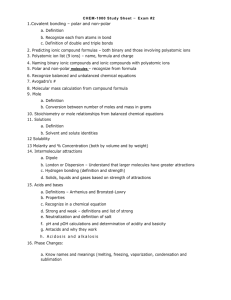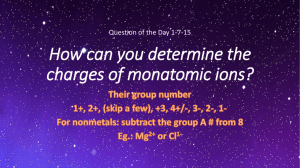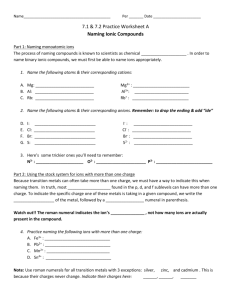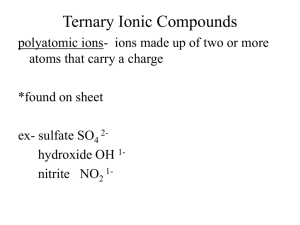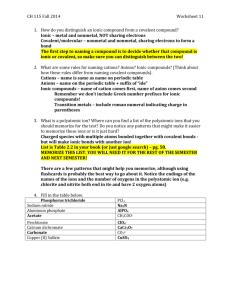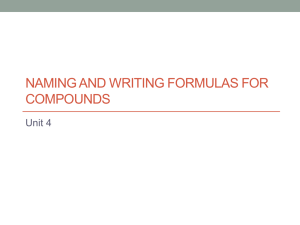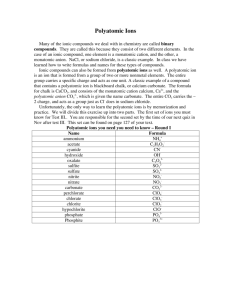III. Ionic Compounds
advertisement
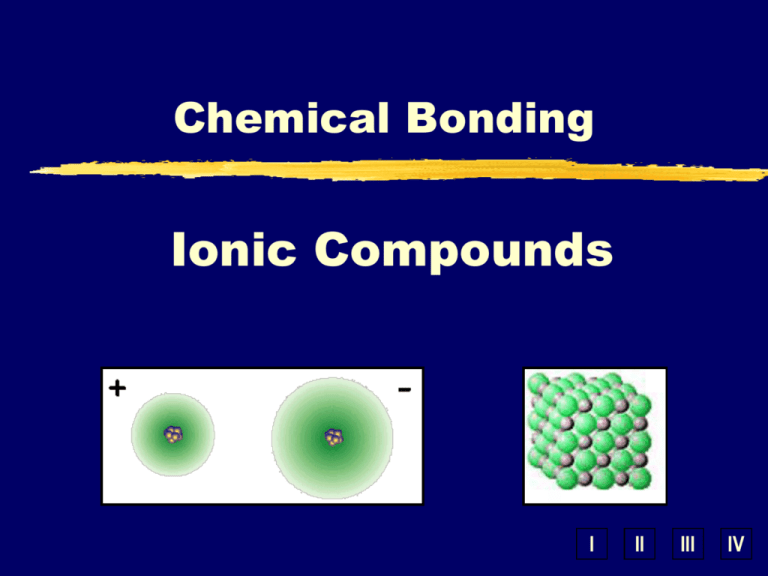
Chemical Bonding Ionic Compounds I II III IV B. Lewis Structures Ionic – show transfer of e- Things to know about Ionic Ionic compounds are made up of? The electrons are being? What is written first? Opposite charges will? How to write a formula Ionic Formulas Overall net charge must equal zero. S.O.C.S Symbols -> Oxidation # -> Crisscross -> Simplify Don’t show charges in the final formula. Writing Formula Practice Potassium Chloride K+ Cl- KCl Aluminum Bromide Al+3 Br- AlBr3 BeS = Reduce Beryllium Sulfide Be+2 S-2 Ionic Nomenclature How to Name an Ionic Compound Write the name of the Cation (Metal) first. It comes straight off the periodic table. Change ending of the Anion (Nonmetal) to end in -ide. Naming Practice Al2O3 Aluminum Oxide CaS Calcium Sulfide Na3P Sodium Phosphide Polyatomic Ions When you have a compound that involves more than 2 elements, you must look at a Polyatomic Chart for help. When writing formulas, keep these ions in parentheses. These ions will also have different endings (-ate) (-ite) Helpful for determining between individual atoms and polyatomic ions Writing a Formula You need to determine if a Polyatomic Ion is present! Look at the ending of the name (-ATE) or (-ITE) What are some exceptions??? What if the ending is (-IDE)? What will you do then? Writing Polyatomics Potassium Nitrate KNO3 Aluminum Sulfide Al2S3 Barium Phosphite Ba3(PO3)2 Naming Polyatomics Look for more than two elements. That’s means a Polyatomic is present. Match up the polyatomics and write the correct names and ending straight from the chart. Practice w/ Polyatomics CaSO4 Calcium Sulfate Ga(IO3)3 Gallium Iodate Writing with Transitions When a Transition metal is involved in the bond, you must identify which form of the atom is bonding. These atoms can have different oxidation numbers. Look for the Roman Numeral in the name when writing the formula. The Roman numeral is the oxidation number of the transition metal. Practice Writing Trans Copper (II) Fluoride CuF2 Zinc (I) Phosphate Zn3PO4 Nickel (IV) Oxide NiO2 (Simplified formula) Naming Transitions When Naming the compound, you must balance the total charge, must be zero! Look at the Anion. Determine the total sum of the charge provided by the Anion. Look at the Cation. Remembering that the sum of the ionic compound must equal zero, determine the positive charge, and roman numeral. Practice Naming Trans Au2S Gold(I) Sulfide Co2O3 Copper(III) Oxide AgN Silver(III) Nitride
